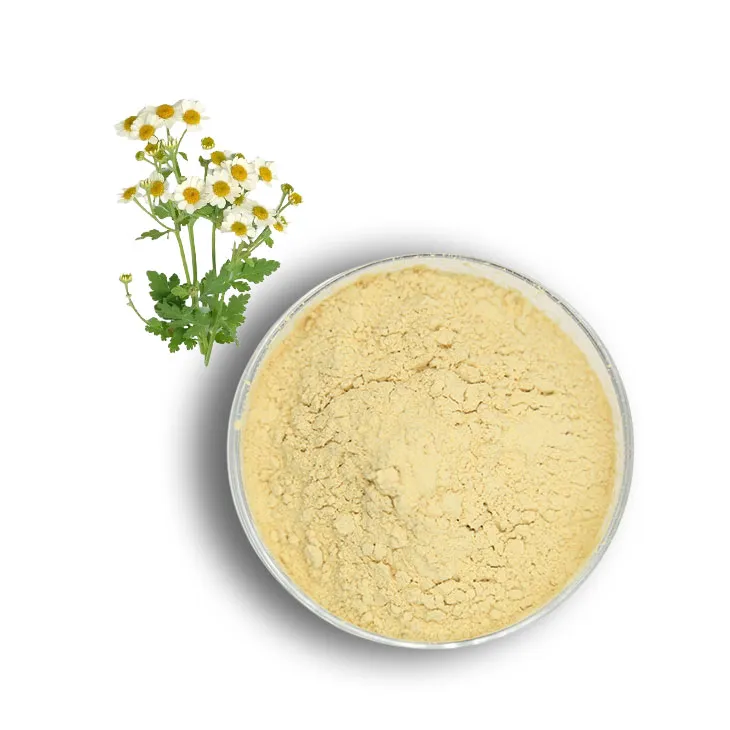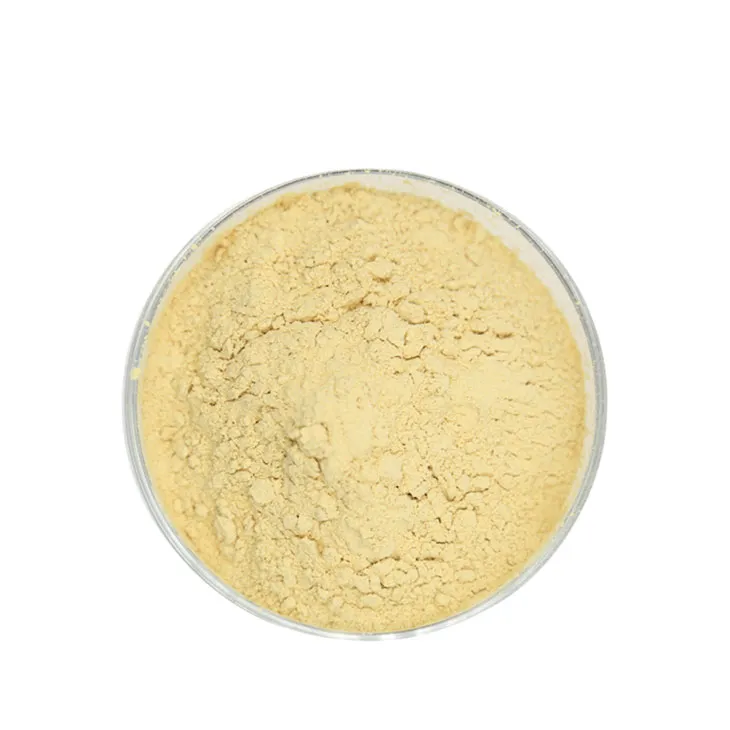- 0086-571-85302990
- sales@greenskybio.com
Four Main Methods for Extracting Feverfew Extract from Plants.
2024-12-18

1. Introduction
Feverfew (Tanacetum parthenium) is a well - known plant with a long history of use in traditional medicine. Its extract has been found to possess various beneficial properties, such as anti - inflammatory, anti - migraine, and antioxidant activities. These properties have led to its increasing use in the fields of medicine and cosmetics. As a result, the extraction of high - quality Feverfew Extract from plants has become an important area of research and industrial application.

2. Maceration Method
2.1 Principle
Maceration is one of the simplest and most traditional methods for extracting Feverfew Extract. The principle behind this method is based on the diffusion of soluble compounds from the plant material into a solvent over time. The plant material, usually dried feverfew leaves or flowers, is soaked in a suitable solvent, such as ethanol or methanol. The solvent penetrates the plant cells, and the active compounds dissolve in it.
2.2 Procedure
- First, collect and dry the feverfew plant parts. Make sure they are clean and free from contaminants.
- Then, grind the dried plant material into a coarse powder. This increases the surface area available for extraction.
- Next, place the powdered plant material in a glass container. Add the solvent in a ratio that is typically around 1:5 (plant material to solvent).
- Seal the container and let it stand at room temperature for a period of time, usually several days to a few weeks. During this time, shake the container occasionally to enhance the extraction process.
- After the maceration period, filter the mixture to separate the liquid extract from the solid plant residue. The resulting liquid is the Feverfew Extract.
2.3 Advantages and Disadvantages
-
Advantages:
- It is a simple and low - cost method. It does not require complex equipment, making it accessible for small - scale extraction, such as in home - based or small herbal medicine laboratories.
- The extraction process is relatively gentle, which may help to preserve the integrity of some heat - sensitive or fragile active compounds in the feverfew plant.
-
Disadvantages:
- It is a time - consuming process. The long maceration time may lead to the degradation of some active compounds, especially if the solvent is not carefully chosen or if the extraction conditions are not well - controlled.
- The extraction efficiency may not be as high as some other methods. This means that a larger amount of plant material may be required to obtain a sufficient quantity of the extract.

3. Soxhlet Extraction
3.1 Principle
Soxhlet extraction is a continuous extraction method. It works on the principle of repeated refluxing of the solvent over the plant material. The plant material is placed in a thimble - like container within the Soxhlet apparatus. The solvent is heated in a flask and vaporizes. The vapor rises, condenses in a condenser, and then drips back onto the plant material in the thimble. This process is repeated continuously, ensuring that the plant material is constantly exposed to fresh solvent, which helps to extract a greater amount of the active compounds.
3.2 Procedure
- Prepare the dried and powdered feverfew plant material as in the maceration method.
- Load the plant material into the Soxhlet thimble and place it in the Soxhlet apparatus.
- Add the solvent (commonly ethanol or hexane) to the Soxhlet flask. The volume of the solvent should be sufficient to cover the bottom of the flask and provide enough for the extraction process.
- Turn on the heat source and start the extraction. The solvent will start to vaporize, condense, and reflux over the plant material. The extraction usually takes several hours to a day, depending on the nature of the plant material and the solvent used.
- Once the extraction is complete, turn off the heat and allow the apparatus to cool. Then, collect the extract from the Soxhlet flask by carefully decanting or filtering it.
3.3 Advantages and Disadvantages
-
Advantages:
- It is a more efficient extraction method compared to maceration. It can extract a larger amount of active compounds in a shorter time, which is beneficial for large - scale industrial production.
- The continuous refluxing process ensures better contact between the solvent and the plant material, leading to a more complete extraction of the desired compounds.
-
Disadvantages:
- The Soxhlet extraction method requires specialized equipment, which is relatively expensive. This may limit its use in small - scale or home - based extraction.
- The relatively high temperature and long - term refluxing may cause some heat - sensitive active compounds in the feverfew extract to degrade, affecting the quality of the final product.

4. Supercritical Fluid Extraction
4.1 Principle
Supercritical fluid extraction (SFE) uses a supercritical fluid as the extraction solvent. A supercritical fluid is a substance that is at a temperature and pressure above its critical point. Carbon dioxide (CO₂) is the most commonly used supercritical fluid in the extraction of feverfew extract due to its non - toxic, non - flammable, and easily removable properties. At supercritical conditions, CO₂ has properties between those of a gas and a liquid, which allows it to penetrate the plant material effectively and dissolve the target compounds.
4.2 Procedure
- First, prepare the feverfew plant material in a suitable form, usually dried and ground.
- Place the plant material in the extraction chamber of the SFE apparatus.
- Introduce supercritical CO₂ into the extraction chamber. The temperature and pressure are carefully controlled to maintain the supercritical state of CO₂. Typical pressure ranges are between 100 - 300 bar, and the temperature is usually around 35 - 60 °C.
- The supercritical CO₂ extracts the active compounds from the plant material as it passes through. The extract - laden CO₂ is then passed through a separation chamber where the pressure is reduced, causing the CO₂ to return to its gaseous state and the extract to be collected.
4.3 Advantages and Disadvantages
-
Advantages:
- It is a clean and environmentally friendly extraction method. Since CO₂ is non - toxic and easily removed, there are no harmful residues left in the extract, making it suitable for use in the production of pharmaceuticals and cosmetics.
- The extraction process can be precisely controlled by adjusting the temperature and pressure. This allows for the selective extraction of specific active compounds, resulting in a high - quality extract.
- It is a relatively fast extraction method, which can save time compared to traditional methods such as maceration.
-
Disadvantages:
- The SFE equipment is very expensive, which requires a large initial investment. This limits its widespread use, especially in small - scale operations.
- The extraction process is complex and requires highly trained operators to ensure proper control of the temperature, pressure, and other parameters.

5. Microwave - Assisted Extraction
5.1 Principle
Microwave - assisted extraction (MAE) utilizes microwave energy to enhance the extraction process. Microwaves can penetrate the plant material and cause the polar molecules in the plant cells, such as water, to vibrate rapidly. This internal heating effect breaks the cell walls more efficiently, releasing the active compounds into the solvent more quickly than traditional extraction methods
5.2 Procedure
- Prepare the dried and powdered feverfew plant material.
- Place the plant material and the solvent (such as ethanol or water) in a microwave - compatible container.
- Seal the container and place it in the microwave oven. Set the appropriate microwave power and extraction time. The power and time settings depend on the amount of plant material, the type of solvent, and the desired extraction efficiency. Typically, the power ranges from 200 - 800 watts, and the extraction time is from a few minutes to half an hour.
- After the extraction is complete, allow the container to cool. Then, filter the mixture to obtain the feverfew extract.
5.3 Advantages and Disadvantages
-
Advantages:
- It is a very fast extraction method. The use of microwave energy significantly reduces the extraction time compared to traditional methods like maceration and Soxhlet extraction.
- The extraction efficiency is relatively high. The rapid heating and cell wall disruption lead to a more complete extraction of the active compounds in a shorter time.
-
Disadvantages:
- The equipment used for microwave - assisted extraction needs to be specifically designed for this purpose. It may not be as widely available as the equipment for other extraction methods.
- There is a risk of overheating the plant material and the solvent if the microwave power and time are not properly controlled. This can lead to the degradation of some active compounds and affect the quality of the extract.

6. Conclusion
In conclusion, the four main methods for extracting feverfew extract from plants, namely maceration, Soxhlet extraction, supercritical fluid extraction, and microwave - assisted extraction, each have their own advantages and disadvantages. The choice of extraction method depends on various factors such as the scale of production, the required quality of the extract, and the available resources. For small - scale or home - based extraction, maceration may be a simple and cost - effective option. For large - scale industrial production, Soxhlet extraction or supercritical fluid extraction may be more suitable, depending on the specific requirements for quality and cost - effectiveness. Microwave - assisted extraction, with its high speed and efficiency, may also find increasing use in the future, especially if the challenges related to equipment availability and process control can be overcome. Overall, the development of efficient and high - quality extraction methods for feverfew extract is crucial for further exploring its potential applications in medicine, cosmetics, and other fields.
FAQ:
What are the four main methods for extracting feverfew extract from plants?
The article doesn't mention the specific four methods yet. It just focuses on introducing that there are four main methods, so we can't answer this question precisely for now.
Why are these extraction methods important in the fields of medicine and cosmetics?
In medicine, high - quality feverfew extract may have certain pharmacological effects such as anti - inflammatory, analgesic, etc. In cosmetics, it may be used for skin care, anti - aging, etc. These extraction methods ensure the quality and purity of the extract, which are crucial for its effective use in these fields.
How can we ensure the quality of the feverfew extract obtained by these methods?
To ensure the quality, factors such as proper plant selection, accurate control of extraction parameters (such as temperature, pressure, solvent type and ratio), and strict purification and filtration processes need to be considered. These can help to obtain a high - purity and high - quality feverfew extract.
Are there any environmental impacts associated with these extraction methods?
Some extraction methods may use solvents, and if not properly managed, the solvents may have environmental impacts such as pollution. However, with the development of green chemistry, more environmentally friendly extraction methods are being explored and adopted to minimize these impacts.
Can these extraction methods be applied on a large - scale industrial level?
It depends on the complexity and cost - effectiveness of each method. Some methods may be easily scalable with appropriate equipment and process optimization, while others may be more difficult due to high costs or complex procedures. But generally, these methods are important for industrial applications as they are the basis for obtaining the extract for further product development.
Related literature
- Study on the Extraction and Application of Feverfew Components"
- "Optimization of Feverfew Extract Extraction Technology for Cosmetic Use"
- "Feverfew Extract in Medicine: Extraction and Efficacy"
- ▶ Hesperidin
- ▶ citrus bioflavonoids
- ▶ plant extract
- ▶ lycopene
- ▶ Diosmin
- ▶ Grape seed extract
- ▶ Sea buckthorn Juice Powder
- ▶ Beetroot powder
- ▶ Hops Extract
- ▶ Artichoke Extract
- ▶ Reishi mushroom extract
- ▶ Astaxanthin
- ▶ Green Tea Extract
- ▶ Curcumin Extract
- ▶ Horse Chestnut Extract
- ▶ Other Problems
- ▶ Boswellia Serrata Extract
- ▶ Resveratrol Extract
- ▶ Marigold Extract
- ▶ Grape Leaf Extract
- ▶ blog3
- ▶ blog4
- ▶ blog5
-
Pure 85% Tomentil Extract.
2024-12-18
-
Saffron Extract Powder
2024-12-18
-
Grapefruit Seed Extract Powder
2024-12-18
-
Hops Extract
2024-12-18
-
White Willow Bark Extract
2024-12-18
-
Bamboo Leaf extract
2024-12-18
-
Hawthorn powder
2024-12-18
-
Peppermint Oil
2024-12-18
-
Mangosteen extract powder
2024-12-18
-
Medicinal Marshmallow Extract
2024-12-18
-
Sugarcane Extract
2024-12-18





















